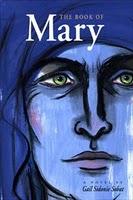The Book of Mary

Initially, this novel annoyed me. It begins with the story of Mary at the age of 14. She is of marriageable age, but she is a willful girl who is not only literate, but a teenager with ideas of her own. She sneaks out at night, and catches the eye of a young man named Jeremiah at a brothel, where she is allowed to dance. Joseph is there, too, and he has his eye on Mary, but she finds him to be dull. Mary and Jeremiah fall in love, and Mary gets pregnant. She then finds that Jeremiah is a rogue. Undaunted and ever resourceful, Mary saves both herself and the baby by concocting a wild lie about being visited by an angel who tells her that she is to give birth to Yahweh’s son. Joseph, who by now has already asked for her hand, is not fooled, but he is easily dominated, and so he goes along with the lie. Her parents, though devout Jews, do as well. And so Mary is married to Joseph, and he takes her to Bethlehem on a camel’s back. You may know rest.
Mary reminds me too much of a stereotype in the beginning. It is a story of a girl becoming a woman and coming into her own, refusing to buckle before authority, no matter how harsh and domineering that authority might be. Sobat repeatedly reminds us that in Mary’s day, women were stoned on a routine basis. This is, in theory, what kindles Mary’s crazy story about a virginal conception. What is so hard to believe, however, is that she actually gets away with it, or with the pseudo hospital and spiritual home for women that she supposedly builds, and which survives, despite the harsh patriarchal rule of law. However, the more I read, the more entranced I became. Sobat is a good story teller, and her Mary becomes a character that it is hard not to fall in love with. And the fact that Sobat comes up with her own version of the story told for 2,000 years becomes rather fascinating. We all know how this one is going to end. But it is the question of what happens to Mary, not to Jesus, that kept this reader turning the page.